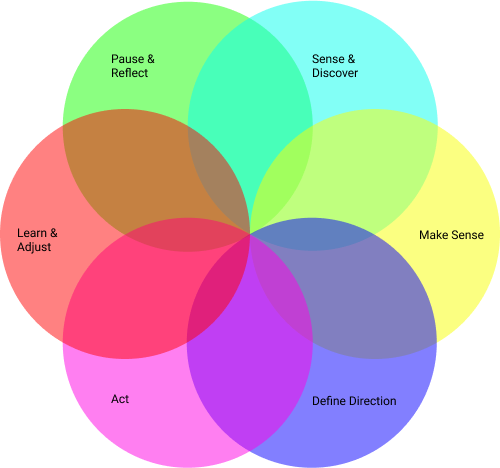
Pause and Reflect
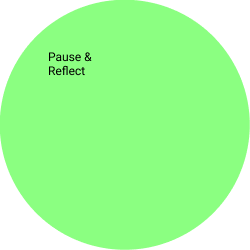
Pause and Reflect is about not rushing into a situation by doing something, but rather by pausing and reflecting about why we are concerned about that specific issue or situation and what we bring with us that might influence how we perceive and likely act in this given situation. It is also about becoming aware of and name our epistemological frames, cultural biases and blind spots – or even just about the fact that these exist, and we have to start noticing them. We also need to acknowledge that current knowledge systems are rooted in an atomistic and hierarchical way of knowing, excluding and even oppressing many other ways of knowing, particularly those outside of Western culture. We need to start observing the observer. Which implies as well that we need to be aware who we mean when we say or write ‘we’.
As part of this, we can also reflect about how we as a group have come together and who else is there that should maybe be part of what we are trying to do – and also notice our resistance to (specific) others being part of what we want to achieve.We can reflect on our assumptions and hypotheses about what needs to happen and notice that they will likely have the shape of a linear logic defining what we would rather see and describing a way to get there. Such a logic is not necessarily wrong, we often naturally think in that way. But when we look at complex situations it is likely that it leaves out a large number of connections that if implemented will lead to unintended consequences. It also leaves out a large number of other ways changing the situation or issues that concern us that we could not have come up with.
Sense and Discover
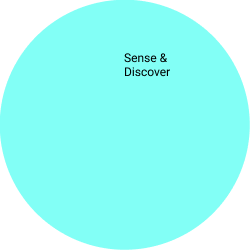
Sensing the system and discovering what is going on is about building a current situation awareness, not about knowing every detail of what is going on. It is essentially about two questions:
- What is known and knowable about the specific situation we are interested in? What do people agree on? What don’t they?
- What are the relevant theoretical and conceptual bodies of knowledge (from different knowledge traditions if relevant) that allow us to better understand ‘how the world works’? Or in other words: what is stable and broadly agreed on wider knowledge that is relevant for us in our situation?
In our enquiry, we need to take a holistic view on the world, not a reductionist one. We need to find the warm data of the interrelationships that build a complex system, not only the cold data statistics give us. We need take a transcontextual approach, taking into consideration multiple perspectives, multiple ways of knowing and multiple descriptions – and the relationships and differences between them. We need to understand how things change with different speeds over time and what paradoxes and inconsistencies are created through that. We need to act culturally responsible, being aware of our own blind spots and take responsibility for them. We need to hold the humility that there are other ways of knowing than our own – including other relevant theoretical and conceptual bodies of knowledge than the ones we chose.
We can map constraints, connections, exchanges, attractors, identities, habitual practices and rituals, diversity, understand roles, scripts, capture and feel the aesthetics, the moods, the rhythms, etc. We need to find multiple descriptions that can capture these different angles, including statistics, reports, narratives of lived experiences, poems, songs and music, painting, etc.
We must enquire like the doctor who does not just know a symptom and prescribes an ailment, but the one who has knowns you from birth, has known your parents, your grandparents and the people in the village you live in – who knows the different contexts that come together to produce that specific symptom and how they interrelate.
Make Sense
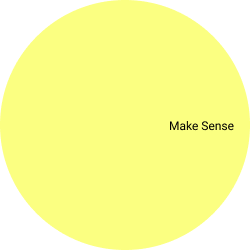
Sense-making is about trying to figure out jointly what really is going on in order to act in meaningful ways. What is going on cannot be completely known but we can calibrate in a group or team what we observe and what we think this means. We should also harvest dissent as a form of diversifying the response to an issue or situation. We do not want to find one possible answer to implement but explore the space of possible answers that we could consider.
We want to get a feel for the dispositions and propensities in a system, be able to map the influencing factors and understand which ones we can influence. We want to see how the patterns are changing over time, what paradoxes and inconsistencies we can see, how different cadences, rhythms change how patterns interact over time.
Sense-making can happen on multiple levels at the same time, leading to different but coherent responses. For example, it can be done by individuals, in local action groups, in organisations, local and national governments, etc. Different levels will make sense in different ways, leading them to choose different paths. This diversity allows for different things being tried.
Define Direction
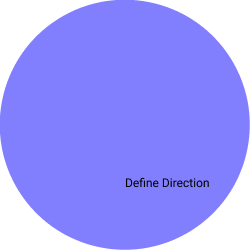
Defining a strategic intent or strategic direction is about figuring out what we consider to be a ‘better’ situation than the one we see now. It is not about describing the ideal future nor about developing a plan on how to get there. We need to get an idea of what the stories are we want to hear more of and what the stories we want to hear less of.
There are naturally many potential versions of what ‘better’ means. Defining direction is about having a broad conversation on what right looks like rather than defining a focus on a narrowly defined intent.
A strategic intent is necessarily formulated on a high level as the details can often not be known in advance. We need to look at general system parameters like equality, resilience, innovation, impact on the environment, etc. rather than specific indicators like changes in turnover or income.
Defining direction also includes to agree with other actors what we can do together and what is desirable for all of us. However, the strategic intent is not an attempt to get everybody to agree on a specific action or plan, but to create a scaffold that allows a common direction of travel to emerge, a vector that brings different people and organisations together for a joint journey.
Act
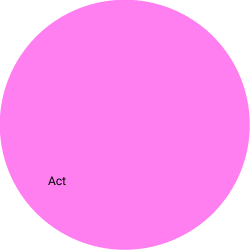
Acting meaningfully in a complex living system is a delicate matter. Yet we are doing it all the time. Indeed, we cannot not influence a system we are part of. The questions here really are: What do we do next? How do we act based on what we know? What are different things we could try to explore the space of the possible? What do we want to contribute to what is essential?
We need to understand how to intervene in a complex living system. Direct correctives do not work and are generally counterproductive. Change often happens as a consequence of a change in perception and a change in relationships. It happens indirectly by rearranging constraints, relationships and interdependencies, not directly by changing behaviours.
Not everything is complex, but we are always acting in the complex contexts of society, economy, ecology, etc. Even complicated interventions like building a bridge can have unpredictable effects on the relationships among people – especially if new connections are enabled that were not possible before.
Possible ways to act are adaptive moves, portfolios of safe-to-fail experiments, or bringing people together in dialogue.
Learn and Adjust
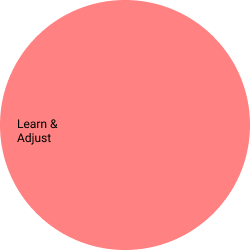
Learning and adjusting is what we need to constantly be doing and all the other elements feed into this one.
Learning is not necessarily (only) about monitoring and measuring change. Of course, we need to be able to assess the consequences of our actions, most importantly the unintended ones (there are always unintended ones). We need to be able to capture weak signals to react early to unintended changes. We need to amplify positive patterns and dampen negative patterns.
Yet learning & adjusting is about much more than monitoring. It is about learning how to be and act together, adjust to each other and with each other.
How to combine these elements
For people who are new to systems and system work, it is the most obvious to set the five elements into a process sequence, starting with a reflection on their own role, then sensing and discovering to get a feel for the system, followed by making sense of the created overview, asking what is really going on here. Once we have a sense of what is going on, we can develop a sense of direction in which the various stakeholder want to travel together and start with small tentative actions to probe the system and then observe how patterns are shifting (or not). Learning and adjusting helps us to understand where more attention is needed or where we need to be careful as we see signs for unintended and potentially negative effects.
At a more advanced stage or when less interested in affecting change, the five elements can be used as different lenses to live in a system. All of them influence our way of being in systems. We need to find times to pause and reflect, times to sense and discover, times to make sense of what is going on, times to define direction of travel and times to act. At this stage, the different elements often bleed into each other and no obvious sequence can be defined. Learning and adjusting is in itself a central way of being in systems, rather than just a means to getting somewhere, as a core way of understanding complex living systems is that they are fuelled by continuous mutual learning.
Who is the ‘we’ in Systemic Insight?
One of the key questions when using Systemic Insight as an approach to systems work is how to decide whom to include in the processes. Our practical experience is that starting with a small group of committed people and later grow the group works best. This allows for creating early traction while at the same time growing a network over time. We are also often asked whether these processes work best when they are initiated by people who live in a place or whether an outside organisation like a national or foreign government agent, a philanthropic foundation or NGO can initiate change processes. We lean towards working with local decision makers who are deeply embedded in the social context and who can adapt measurement systems, resource allocation and priorities based on an evolving local context. It is their ability to make locally informed decisions about priorities, resource allocation and appropriate measurements that matters the most.